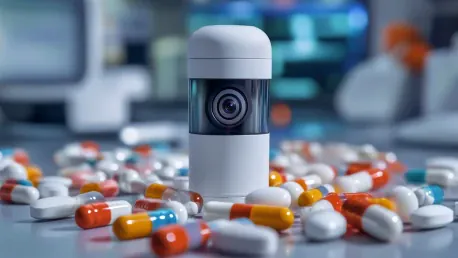The healthcare industry is witnessing an unprecedented advancement with the introduction of AI-powered wearable cameras designed to detect and prevent medication errors. These errors are a significant concern, contributing to a substantial number of preventable harms, with medication errors alone causing an estimated 140,000 to 440,000 deaths annually in the United States. Adverse drug events are particularly prevalent in high-risk settings such as operating rooms and intensive care units, where mistakes can have devastating consequences.
The Scope of Medication Errors
Prevalence and Impact
Medication errors are alarmingly common, with 5% to 10% of all administered drugs involving some form of error. Injectable medications, in particular, impact a staggering 1.2 million hospitalizations annually, resulting in costs amounting to $5.1 billion. Anesthesiology experiences the highest frequency of such incidents, primarily due to the complexity and precision required in this field. Notably, syringe and vial swaps account for 20% of errors, and another 20% involve improper administration of correctly labeled drugs, further highlighting the critical need for improved safety measures.
These errors predominantly occur during the preparation of intravenous injections when medication is transferred from a vial to a syringe, a process fraught with potential pitfalls. Incorrect labeling or selecting the wrong vial can lead to significant harm. The severity of these problems is underscored by the fact that a mere 2% of such errors are intercepted before reaching the patient in hospital wards. This glaring statistic underscores the urgency for more effective interventions to curtail these potentially dangerous mistakes.
High-Risk Scenarios
Errors during the preparation of intravenous injections are the most likely to occur, particularly when medication is transferred from a vial to a syringe. The risks of incorrect labeling or selecting the wrong vial are compounded by the fast-paced and high-pressure environments of healthcare settings, where even a minor oversight can have grave consequences. The complexity and urgency of these settings demand solutions that can keep pace with the swift actions and decisions of healthcare professionals and ensure patient safety.
Additionally, the dynamic and often chaotic nature of operating rooms and intensive care units heightens the likelihood of medication errors. These environments are characterized by rapid hand movements, partial views, and frequent interruptions, all of which can increase the chances of mistakes slipping through. The challenge lies in creating solutions that can seamlessly integrate into these demanding workflows without imposing additional burdens on already overworked healthcare providers.
Existing Measures and Their Limitations
Traditional Safety Protocols
Various measures have been implemented to reduce medication errors, including color-coded labels, tall-man lettering, standardized safety protocols, prefilled syringes, and barcode scanning. Each of these safety protocols has been devised with the intention of minimizing the likelihood of errors and enhancing overall patient safety. However, these methods require active participation from clinicians, who, driven by time constraints and workload pressures, frequently bypass safety mechanisms. This behavior, while aiming to save time, unfortunately, increases the likelihood of errors, undermining the very purpose of these safety protocols.
The limitations of traditional safety protocols are further exposed by the reality that human errors are an inevitable part of any process reliant on manual intervention. Despite the clear benefits of these measures, their efficacy is compromised by the inconsistencies and fallibilities of human behavior. As a result, there is an urgent need for safety solutions that do not rely solely on manual interaction but can passively bolster the error-prevention efforts in clinical settings, thereby ensuring a higher degree of patient safety.
The Need for Passive Solutions
Given the dynamic and fast-paced nature of clinical settings, there is a pressing need for passive solutions that do not rely on manual interaction. This realization is what propelled the development of the AI-powered wearable camera system, which offers a reliable secondary check without requiring additional effort from clinicians. By seamlessly integrating into the clinical workflow, these wearable cameras can significantly reduce medication errors without adding to the workload of healthcare professionals.
Passive solutions are particularly valuable in environments where clinicians must work quickly and efficiently. The AI-powered wearable camera system leverages advanced technology to provide real-time alerts and checks, thereby enhancing the overall safety of drug administration practices. This technology represents a significant leap forward in patient safety, promising a future where medication errors are substantially minimized through intelligent, automated interventions.
The AI-Powered Wearable Camera System
How It Works
The AI-powered wearable camera system operates by using deep learning algorithms to identify and compare syringe and vial labels in real time by analyzing video footage captured by head-mounted cameras. This advanced technology works by recognizing visual cues such as vial cap color, label print size, and syringe shape. It alerts clinicians to any mismatches before medication is administered, serving as a reliable secondary check and ensuring that the correct medication is given to the patient.
The system has been rigorously tested to ensure its effectiveness and reliability. Researchers collected extensive data to train the AI model, capturing 4K video of drug preparation by anesthesiology providers in real-world operating room environments across multiple hospitals and operating rooms over an extended period. By analyzing this comprehensive dataset, which included variations in lighting, clinician techniques, and medication types, the AI model was able to achieve a high degree of accuracy and robustness.
Impressive Results
The results of the testing were impressive, with the system achieving a sensitivity of 99.6% and a specificity of 98.8% in identifying vial swap errors. These results were obtained by capturing 4K video of drug preparation in real-world operating room environments across two hospitals and 17 operating rooms over 55 days, covering 418 drug draws. This extensive dataset ensured that the AI model was trained with a diverse range of scenarios, enhancing the accuracy and reliability of the system.
Unlike traditional methods such as barcode scanning, which require manual interaction, the wearable camera system passively analyzes visual cues and provides real-time feedback. This passive approach is particularly valuable in dynamic clinical settings, where clinicians work quickly and may not fully expose labels. The system’s ability to distinguish between medications and unrelated items in the background further ensures its reliability and effectiveness in preventing medication errors.
Advantages Over Traditional Methods
Passive Analysis
One of the key advantages of the AI-powered wearable camera system is its passive analysis capability. Unlike traditional barcode scanning methods, which require manual interaction and may be prone to human error, the wearable camera system passively analyzes visual cues such as vial cap color, label print size, and syringe shape. This ability to operate without manual intervention is particularly valuable in dynamic clinical settings where clinicians work quickly and may not fully expose labels.
The passive analysis capability of the wearable camera system ensures that medication errors are identified and prevented without imposing additional burdens on healthcare professionals. By providing real-time alerts and checks, the system enhances overall patient safety and allows clinicians to focus on delivering high-quality care. This feature underscores the potential of AI-powered technologies to revolutionize drug administration practices and reduce the incidence of medication errors.
Robust Model Training
The robustness of the AI model is another significant advantage of the wearable camera system. The model has been trained with extensive data, capturing 4K video of drug preparation in real-world operating room environments across multiple hospitals. This training data included a diverse range of scenarios, such as variations in lighting, clinician techniques, and medication types, ensuring that the AI model can accurately identify and prevent medication errors in various clinical settings.
The AI model’s ability to distinguish between medications in the foreground and unrelated items in the background further enhances its reliability and effectiveness. By focusing solely on the drugs being prepared, the model ensures that the camera system provides accurate and timely alerts, preventing errors before they reach the patient. This level of precision and sophistication underscores the transformative potential of AI-driven solutions in improving patient safety and medication administration practices.
Expert Insights and Future Potential
Preventing Errors in Real-Time
Dr. Kelly Michaelsen, an anesthesiology professor and co-lead author of the study, highlighted the importance of preventing errors before they occur, emphasizing the system’s power to help patients in real-time. She pointed out that while perfect accuracy is an aspirational goal, the system’s performance exceeds the 95% threshold desired by most anesthesia providers. This level of accuracy provides confidence that the wearable camera system can significantly reduce medication errors and improve patient outcomes.
The real-time error-prevention capability of the wearable camera system is particularly valuable in high-risk settings such as operating rooms and intensive care units. By providing timely alerts and secondary checks, the system ensures that potentially dangerous medication errors are identified and corrected before they can harm the patient. This proactive approach to error prevention represents a significant advancement in patient safety and underscores the potential of AI-powered technologies to transform healthcare practices.
Overcoming Training Challenges
Shyam Gollakota, another coauthor and a professor of computer science, noted the challenges of training the AI model due to the partial views and rapid hand movements in operating rooms. Despite these obstacles, the system showcased its sophistication and reliability in analyzing various scenarios. The ability to accurately identify and prevent medication errors in such challenging environments highlights the robustness and effectiveness of the AI-powered wearable camera system.
The success of the AI-powered wearable camera system in overcoming these training challenges underscores the potential of AI and deep learning technologies in healthcare. By leveraging advanced algorithms and extensive training data, these technologies can provide accurate and reliable solutions to critical healthcare challenges. The wearable camera system represents a significant step forward in patient safety, with the potential to inspire further innovation and advancements in the field.
Broader Applications and Future Innovations
Transforming Clinical Practices
The wearable camera system represents a significant advancement in patient safety, with the potential to transform drug administration practices in various clinical settings, including operating rooms, intensive care units, and emergency departments. By providing real-time alerts and secondary checks, the system enhances overall patient safety and allows clinicians to focus on delivering high-quality care without worrying about medication errors.
Researchers also foresee broader applications for AI and deep learning in healthcare, aiming to improve both safety and efficiency across various clinical workflows. The success of the wearable camera system in preventing medication errors highlights the potential for AI-powered technologies to address other critical healthcare challenges and improve patient outcomes. This transformative potential underscores the importance of continued innovation and investment in AI-driven solutions for healthcare.
Inspiring Further Innovation
The healthcare industry is experiencing remarkable progress with the advent of AI-powered wearable cameras aimed at detecting and preventing medication errors. These errors are a matter of great concern, contributing to a significant number of avoidable harms. Medication mistakes alone are responsible for an estimated 140,000 to 440,000 deaths each year in the United States. This issue is particularly acute in high-risk environments such as operating rooms and intensive care units, where the consequences of errors can be catastrophic. By incorporating advanced AI technology into wearable devices, healthcare providers hope to reduce these errors significantly. These innovative cameras can monitor and analyze actions in real-time, providing immediate feedback and alerts when potential mistakes are identified. This proactive approach not only aims to enhance patient safety but also to improve overall healthcare outcomes. The potential of these AI-driven solutions represents a new frontier in medical care, promising to mitigate risks and enhance the quality of treatment across various healthcare settings.









